Meera - I'm at the Shamwari Game Reserve in Port Elizabeth in South Africa. Shamwari is one of the largest private reserves in the country, hosting the big five animals: lions, leopards, rhinos, buffalo and elephants. It's a beautiful day here today and I'm at Long Lee manor, one of the many lodges that you can stay in here. I'm here with John O'Brian, the Group Ecologist for Shamwari. I can see a vast expanse of land from here. How big is Shamwari?
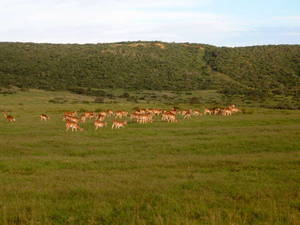 John - Shamwari's between a total of 7 and 5 thousand hectares. It's a substantial piece of land and the majority of it is natural vegetation. It is historically old agricultural lands that we've had to restore.
John - Shamwari's between a total of 7 and 5 thousand hectares. It's a substantial piece of land and the majority of it is natural vegetation. It is historically old agricultural lands that we've had to restore.
Meera - You're quite lucky in that you have a written record of the animals that used to be here.
John - There's a place on Shamwari which crosses the Bushman's River. The Bushman's River runs for about 29km through the reserve. It's the only place that you could cross the river historically by ox wagon. As a result all your early hunters, explorers used to cross there and actually camp on the banks of the Bushman's River, right on the property. Then they'd reference to all the animals they saw or shot or whatever it may have been in the early days. Somebody has actually gotten together and compiled all those notes into a book. From one book we can determine what was historically in the area.
Meera - What is involved in managing a place like this?
John - I think in essence it's - we want to be sustainable in the long term on a few fronts. First of all: ecologically. In other words Shamwari's got to be in better condition two years down the line than it is now. Second of all, we want to be sustainable financially because we are a private game reserve. We don't get subsidies. Then the third aspect is we need to be sustainable socially. When I say socially I don't just mean for the people in the area. I'm talking about South Africa. Anybody who owns land in South Africa must make sure it has a positive contribution to the economy and the social issues of the country.
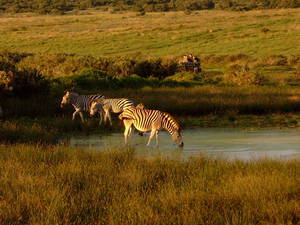 Meera - As well as making the reserve sustainable in terms of the people coming here and things like that the conservation and the ecology side is obviously very important. You have to control the plants here in order to provide the food for the herbivores and then you also need to control the predators having their prey. What are the techniques or methods you use to monitor this?
Meera - As well as making the reserve sustainable in terms of the people coming here and things like that the conservation and the ecology side is obviously very important. You have to control the plants here in order to provide the food for the herbivores and then you also need to control the predators having their prey. What are the techniques or methods you use to monitor this?
John - That is probably the most important thing - the balance. The most important monitoring concept we have is the vegetation management. In essence that is what controls everything. With no vegetation you've got no herbivores and you've got no predators either. In this area some of the vegetation's very sensitive and if ruined or degraded completely it can take anything from 3-5 hundred years to regenerate itself. We have a vegetation monitoring system. We have a predator monitoring system where we monitor the impact of the predators on the prey. Then we've got various environmental monitoring systems to do, water monitoring. In essence we do annual game counts and just making sure that the system is functioning.
Meera - What do you actually do to monitor?
John - With the vegetation monitoring, for example, we have 91 fixed point sites on the reserve where we have a statistical scientific way of determining change in the vegetation as well as fixed point photography. We do that annually and then try and assess the changes as positive/negative; if it is negative what is causing it and then try to rectify it. From a predator point of view we have a daily team that actually monitors the predators and records all the kills. From a human impact point of view we like to do a lot of work in terms of looking at the impact of lodgers etcetera on the water quality. We're permanently doing water tests and carbon footprint tests, those sorts of things.
Meera - Now we're going to go out and have a look at some of the keep plants and vegetation here and the herbivores that then feed on them. It's mid-morning so it's not a very good time to see predators in action really, is it?
John - Certainly not in action. They will be out there somewhere but the chances are they could be resting in the thicket, in the shade, maybe not necessarily viewable. Also animals have to be somewhere: elephants aren't too far from here.
Meera - Let's go and have a look...
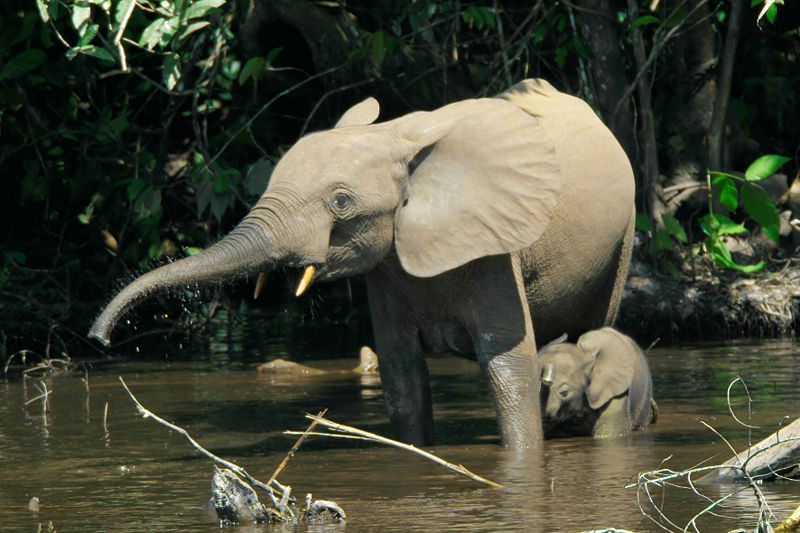 We're just by a group of elephants now. What are these elephants up to at the moment? There's a group of them and I think they're mothers because there's lots of baby ones around.
We're just by a group of elephants now. What are these elephants up to at the moment? There's a group of them and I think they're mothers because there's lots of baby ones around.
John - yeah, this is a nice little herd. You always find that elephants are led by the matriarch, the eldest and wisest of the females. They're just slowly grazing as they go through this area but they're making their way to the river. It's approaching midday, it's getting warm so they're going to bathe in the river.
Meera - When it comes to controlling the numbers of elephants what are the things you need to think about here at Shamwari?
John - I think elephant are probably the most difficult. You can look at contraception, even doing vasectomies in males these days/. I think one of the biggest problems is that they have the potential to be one of the most destructive animals next to man. We monitor very carefully the impact they're having on the environment on Shamwari. We don't have an issue, everything's going according to plan and we're happy. One little thing though is that they love a specific tree: the cabbage tree. It's a nice soft tree that they specifically seek out because they love it so much. You often find that the cabbage tree will be in the middle of a big bush camp. They're destroy that whole bush camp just to get at that one cabbage tree. In essence their impact is fairly negative, I mean fairly minimal, rather.
Meera - We're off to another part of the reserve now.
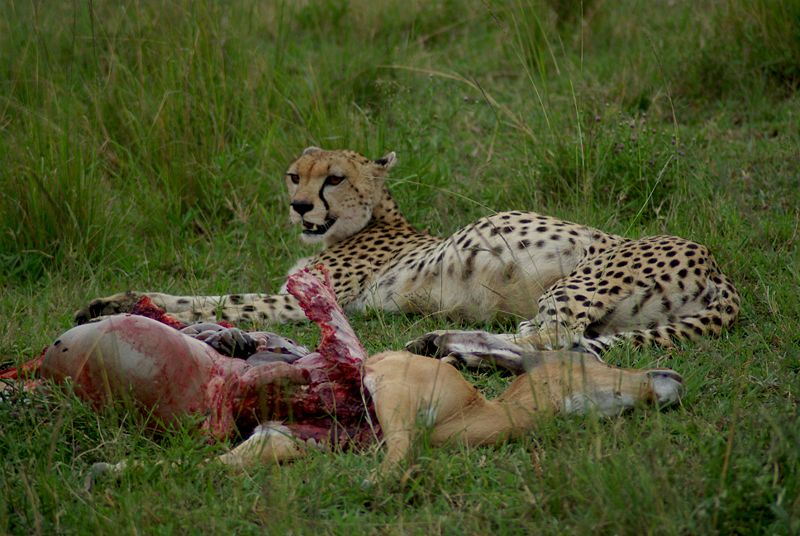 John - Let's just go and see what's around. Somewhere very nearby here is a cheetah on a kudu kill. It's underneath a guarri tree. All we need to do is find the guarri tree and there we go. You see it over this side, it's actually feeding.
John - Let's just go and see what's around. Somewhere very nearby here is a cheetah on a kudu kill. It's underneath a guarri tree. All we need to do is find the guarri tree and there we go. You see it over this side, it's actually feeding.
Meera - Oh my god, yeah! Uh oh, it's spotted us. Does that matter?
John - No, they're very relaxed. It's feeding so it's got other things on its mind. Cheetahs aren't animals that are dangerous to humans.
Meera - We've pulled up alongside this tree and I can just see the cheetah's body and its head and its tail's wagging now. It is just, quite literally, having a feast down there: munching away.
John - You see this right atapan? The watering hole. It's probably hanging around here, the kudu came to drink and it killed the kudu. The first thing that it'll do is it'll drag it under a tree somewhere. That's for a couple of reasons. One: it's frightened. The other reason is to hide it from other scavengers or other predators like a lion. It'll probably feed it for the whole day.
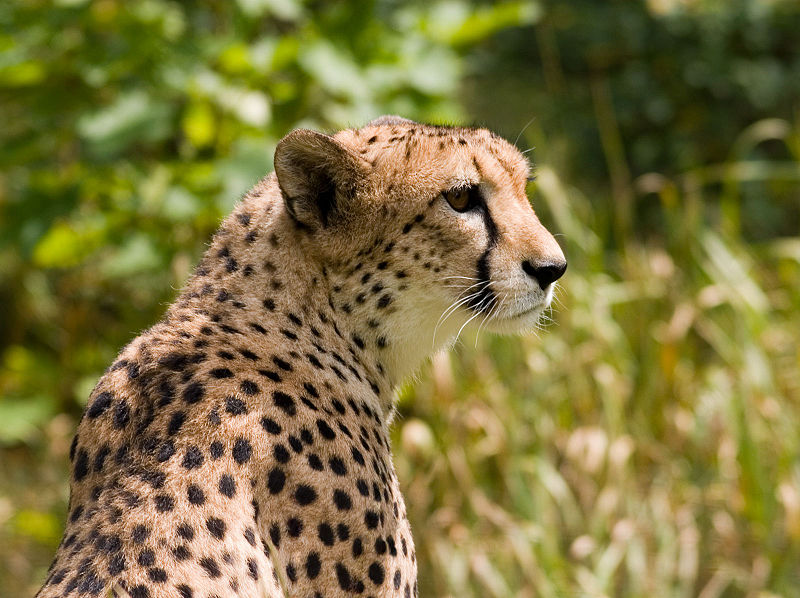 Meera - Do they mainly feed on kudus or many other things too?
Meera - Do they mainly feed on kudus or many other things too?
John - Young kudu often are quite a high percentage of their diet. No they feed on a variety of antelope: all the way from duiker all the way through to adult kudu.
Meera - It just put its head up now and it's just got a mouth full of blood.
John - Yeah, you can see the mouth full of blood there. What a cheetah can do is they can actually feed on antelope. They never have to drink ever because they get enough moisture from the plants. The cheetah can actually, through the blood, get all the moisture it needs. It can go through a whole cycle of not having to drink water. With water yeah they do drink. They always start with the succulent parts around the rump and that's where they get the most moisture from and that's why the face is so red at the moment.
Meera - How are the cheetah populations here? Are they quite easy to control?
John - Cheetah are up and down. One thing is the cheetah is vulnerable to lion. The population is actually quite stable. It's working nicely, there is some youngsters around at the moment. It's working well.
Meera - I think let's leave it to finish off its lunch, I guess.
John - he's having a nice quiet feed so we'll leave him to it.
Meera - We've left the vehicle now and walked up into a higher part of the park; the southwest corner. One thing I've noticed is that the land around here is quite dry at the moment.
John - We've been having quite a difficult time of it of late with rain. We've been having rain but no follow-ups in between. It's a bit of a problem. We're quite concerned the river's very low. We had rain that saved us about three or four months ago because we were really dry. If we don't get a bit of follow-up now we are concerned, yes.
Meera - You've brought me to a particular plant here which seems to be very important when conditions are as dry as they are now.
John - Very much so. This area inland, this vegetation is what's known as a transitional subtropical thicket. One of the key characteristic species you get here is a 'speckworm' which means the bacon bush or fat bush. It's a succulent and why it's so important is that all though it's not utilised that much by animals during the good times it contains a lot of water. During the droughts it's this plant that actually saves the day. Animals really love it.
Meera - You've got a leaf here in your hand and you're breaking it apart and you're right it's filled with water.
John - Not only is it filled with water, it's filled with a lot of nutrients and you can actually use it in stews yourself. You should try one it's actually quite nice. You'd lose a bit of hair on your teeth but we munch on it every now and then ourselves when we have a hot day. This subtropical thicket is probably the best you can get in the world for elephant and black rhino.
As we walk back to the car: if you have a look you can see there is some hyena dung. You can see it's white because it's calcium. They eat the bones and fill the scavenger role. As you walk you can see a whole variety of antelope spore, warthog spore. Spore is basically tracks. Here you can see a line track. It's been slightly rained on so it would probably be from yesterday morning.
Meera - As well you can just see these small amounts of things just to figure out the movement of the animal?
John - Here you've got a millipede which you can see has walked over there with hundreds of little legs. Whenever you go round you're not only looking for animals, you're also looking for what animals have been here. That gives you a good indication of what's here, what's what and what's happening on the property.
Meera - An important issue when it comes to game reserves is the fact that the animals are contained. The land is fenced off. Does this affect their natural migration patterns that they would have had otherwise?
John - I think from a historical point of view but times have changed. Africa has changed. Certain movements have been restricted. You do get many migrations on a much smaller scale. Even in areas like central and Eastern Africa where animals still do migrate you do find you end up with human-animal conflicts. That is starting to be a big issue out there and Mozambique is sitting with the same problems at the moment. Where you get self-sustaining populations of people in terms of small maize fields and that sort of thing you're going to have conflict with elephant. Where you have pastorialism with cattle you are going to have problems with predators. You are finding that the animals are restricting themselves naturally to the protected areas. The other thing to think about in migration is sometimes migration is specifically with elephants it would have been over vast distances. They used to migrate from where we are now all the way down the garden route towards Mossel Bay, inland through the Karoo: hundreds of kilometres. Put that in today's society there'll be taking a ride through some major towns in South Africa. Obviously things have changed. Westernisation has taken place. The development is there and we've got to adapt our conservation methods to suit everybody including the animals.










Comments
Add a comment